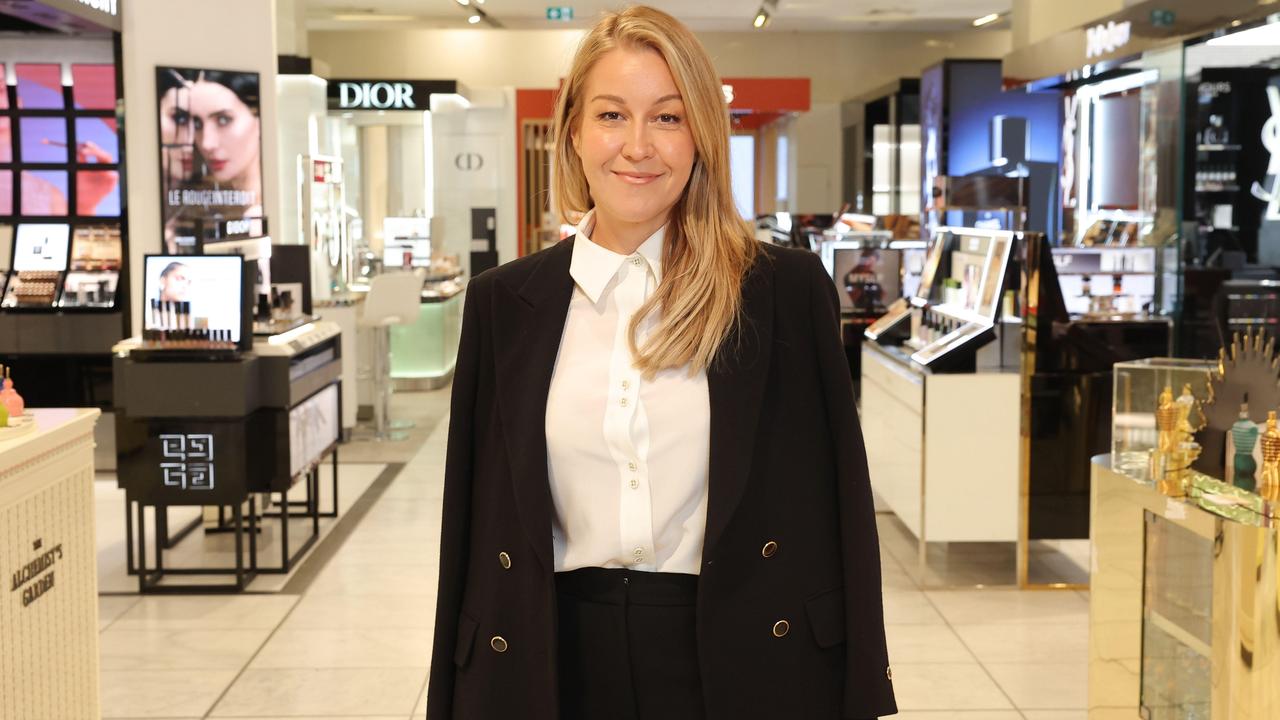Booking.com’s new European HQ kicks major workplace goals
A company founded in an attic may have just provided the blueprint for employers wanting to woo workers back to the office.
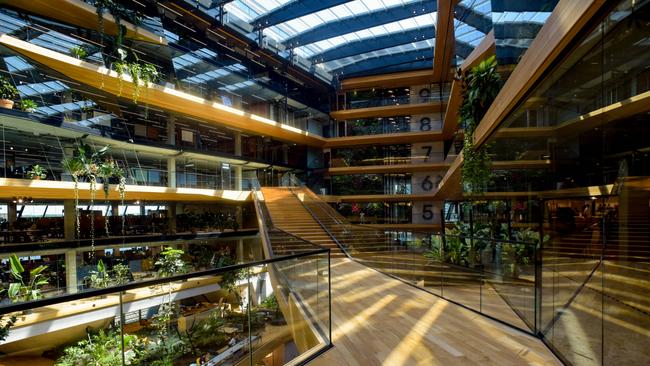
Business
Don't miss out on the headlines from Business. Followed categories will be added to My News.
It was 2015 and Booking.com had a problem. The market capitalisation of its parent company had grown more than five times since a Wall Street debut near the turn of the century. But at home in the Netherlands, employees of the travel booking website – founded in an Amsterdam attic in 2006 – were frustrated.
They were spread across 12 office locations sprawled around the capital. Meeting in person meant travelling from one to another. Often, they couldn’t tell where colleagues were located. They complained about time wasted finding each other.
Executives saw the limitations on future growth. But there was no available office space in the city big enough to fit its purposes. The travel company was hemmed in by its own location.
In a post-pandemic world, where workers may sit in not 12 but 12,000 locations, what is the role of the office? For Atlassian, it’s a symbolic building with attendance optional. Amazon has made presence mandatory five days a week. But either way, say architects and human resource managers, the psychological needs imposed on the building are greater than ever.
Ideally, it should incite workers to visit when they don’t have to – and fortify wellbeing when they do. Its physical structures should better than ever support opportunities for intellectual and social exchanges. At its peak the office campus can forge a strong psychological anchor for even the occasional visitor – cementing a brand relationship and transforming employees into ambassadors.
That’s possible with a marriage of functional form, aesthetic comfort, intelligent design and employee trust.
Today the Booking.com headquarters stands as a 65,000 square metre landmark near central Amsterdam, one of the largest office buildings constructed in western Europe.
Adjacent to major canal thoroughfares at the east end of Oosterdokseiland, it was the last available site on the island – painstakingly reclaimed over a 30-year project – when snapped up by the company. Fresh out of alternate options, the asset-light technology group – which had never held property or participated in developing it – decided to construct its own, funded entirely with its own capital.
Everything was outsourced: from project management (Bouwfonds Property Development), to structural engineering, to interior architecture and design (created by 10 teams, with individual contractors brought in for specific furbishings like carpet and lighting).
“We hired professionals, who knew about real estate development, to work with the developers, architects, all of the people [involved] to build it,” says chief executive Glenn D. Fogel.
As is best practice, employees were extensively consulted through the process, adds Marnix Mali, group director of real estate and workplace services. “One of the main things they said was, ‘we want to be able to find each other!’”
Knitting together 6000 tonnes of steel (two thirds the amount of the Eiffel Tower) and encased by glass, the finished structure uses floor-to-ceiling and multi-level windows for a porous relationship between its interior and the views of cultural landmarks, canals, and sky beyond. Its nine floors circle a central atrium — with interior glass walls enabling visibility from the centre to any floor. To hammer home the point, each floor is labelled with its own full-height number.
Liberal use of Californian oak softens the surface texture, carving spaces down to human scale and embellishing the structure with a more elaborate geometry. It’s used in canopies and mezzanines, balconies and benches, and a cross level walkway (from floors five to six, 23m long).
There are also indoor plants: eleven thousand, including seven full-size indoor trees. “We have two gardeners who come on Tuesday and Thursdays,” Mali says. “They know every single one of them.” Visually, it’s closer to Changi Airport than traditional office cubicles.
Coming together
Booking.com has a hybrid working model, with office presence required three days each week. “We want our people to have any flexibility they need, but we also believe it’s important for us to come together,” says Mali.
Upwards of five thousand staff use the campus, with peak use days mid-week and the lowest on Monday, at around 1500 attendees.
Each locally employed team has a designated home area, or “team base”. But access is unrestricted, with staff free to roam all 1000 rooms at will. It’s assumed any range of work situations might call for a solo seat in a miniature library, a kitchenette catch-up or a meeting room with state-of-the-art audio visuals.
High value is placed on close access to any physical needs. That means an overabundance of photocopiers, toilets (386, the most prominent being gender neutral) coffee machines (84) – and eye-catching signposts, with pictographs, at crossroads for high visibility.
Air filtration produces 325,000 cubic metres of fresh air every hour, and sensory preferences are specifically catered for — with a wide range of light and sound settings, and colour schemes from white and grey to pink and green. The Booking.com brand signature “St Patrick’s blue” (a cousin to ultramarine) makes a frequent appearance.
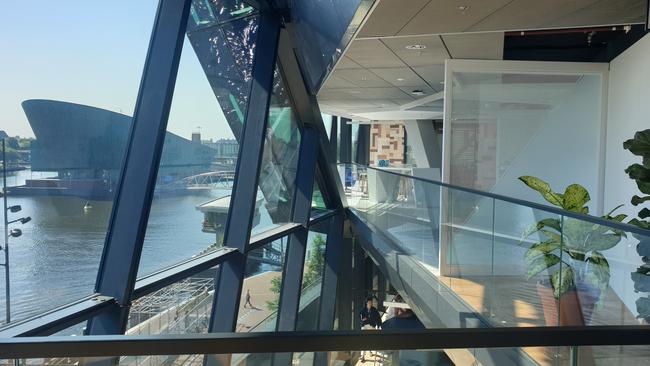
Flows of movement are clearly guided towards central gathering spaces, including 28 communal spaces and three major restaurants, with desks concentrated distally to the east and west of the building. But social opportunities are widely dispersed. Kitchenettes can double as meeting rooms, with liberal table space and seating, and employees stack their own dishwashers – responsibly – in a mark of shared social responsibility. Board games and books are on open display.
Even the TV studio doubles as an interactive opportunity, with presenter lounges bleacher seating for audience participation. (“I’m having my Oprah moment!” exclaims one visiting executive.)
Other behavioural nudges are also built in. Stairs sit in central view, with lifts hidden away in corners. “You have to go looking for them,” says Mali. Table tennis, rock-climbing walls, and gymnastics rings are sprinkled across multi-use spaces. In the underground parking garage, there’s room for 2500 bicycles.
And employees can bring their children in with them anytime they like, Mali says. “We used to put no restrictions on that at all, but then we did find some kids were wandering around on their own. So now we say, ‘you have to be with them!’ But that is the only restriction.”
Holiday feeling
Of course, comings and goings are Booking.com’s raison d’etre. Human resources takes that literally: “It’s not just a job, it’s a journey,” the careers page boasts. They have to – attracting top tech talent is a competitive field. Dutch nationals are the minority among Oosterdokseiland’s local staff, and corporate visitors flow in from more than 200 offices in dozens of countries around the world. Locals have become used to sharing spaces and interacting with strangers.
“We want them all to feel equally at home, whether they moved to live here or they’re just visiting for a few days,” says Mali. That means the “Five Islands” lunch restaurant has a decisively international flavour. On two daily menus (one always vegan), there might be a Latin American beef stew, served with coleslaw; or a West African style jollof rice, with sweet potato, banana chips, and salad.
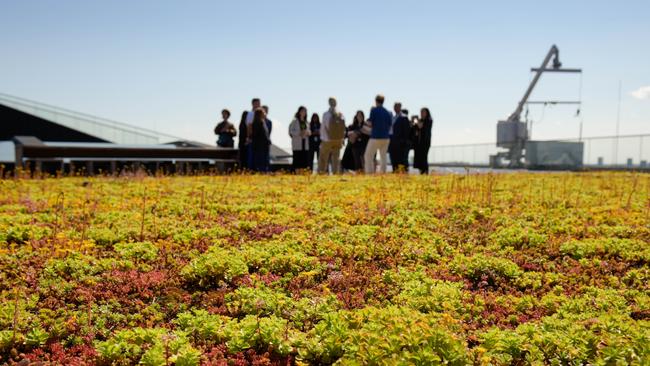
A 24-hour “snack bar” wall is stuffed with the likes of spanakopita and toasted sandwiches, and the ground floor breakfast cafe serves a grab-and-go meal of orange juice, dairy cup with chia or oats, croissant and coffee or tea for just €1.50 (Alternately, a barista-staffed coffee station brews to order at €1.30 per cup.) “It feels like a hotel, really, only cheaper” says one visiting executive “I don’t need to go anywhere else at all when I’m here.”
Meanwhile, all 28 communal breakout areas are themed around micro holiday destinations. Employees can walk through Vienna on their way to Riad, before heading upstairs to Tokyo. In a touch of personalisation, staff’s own favourite holiday snaps hang on the walls. “We had a competition to decide which ones to hang up – people were really excited about it,” says Mali. “And it helps us to get to know a little more about each other.”
Green spaces
Sixty-five per cent of Booking.com’s travel customers prefer vacation products with eco-friendly branding, and green living is a big part of the campus message.
“We wanted to make this a symbol of our commitment to sustainability – and to make sure we built this to the highest level of sustainability,” chief executive Fogel explains, as motivating the BREEAM excellent standard accreditation for building certification.
Toilets are water-saving, sensors regulate lighting and heating to real-time occupancy of each area, and solar panels operate on the rooftops (levels nine, 10 and 11). Amsterdam’s local “Warmte Koud Opslag” temperature technology stores hot and cold air deep underground for use in winter and summer, eliminating the need for gas.
Wildflowers on the rooftops promote insect biodiversity – and supply the tea bar with freshly picked herbs – but a line was drawn at installing bee hives. “Some people were suggesting that,” says Mali, “but in the end we decided the value of putting bees to work and making our own honey was outweighed by the values of being able to sit and eat lunch here peacefully without thinking about the risk of getting stung.”
On the social side, a key goal is increasing footfall to Oosterdokseiland and improving public amenities for neighbours and other entrepreneurs.
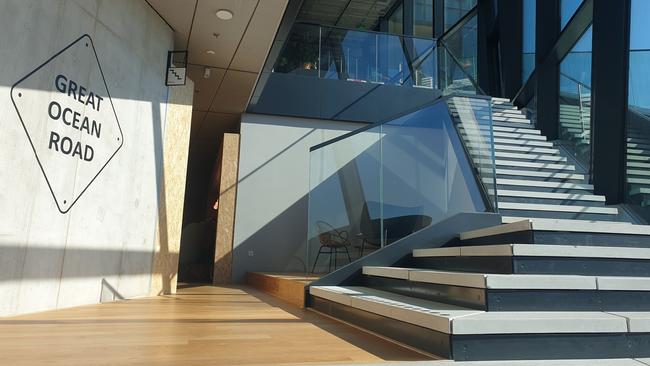
Public access restaurant “A Beautiful Mess”, run by a refugee partnership, trains new arrivals with practical skills and study qualifications, while a bicycle repair shop will soon open, staffed by locals experiencing homelessness.
Separately, the southeast corner holds apartment buildings set aside for public rental or short-term stays.
So how much did it all cost?
“Not unlike every home renovation, it always takes longer than you think it’s going to take, and always costs more than you think it’s going to cost. Which is exactly what happened here!” says Fogel.
Just as construction was peaking, the pandemic hit, condemning staff to their homes. Office values plunged around the world. Everything slowed down.
“That caused problems, and obviously problems with supply chains, and being able to get materials in.”
But Booking.com hadn’t intended to retain ownership of its campus. “We are an asset light company, we never wanted to own it,” Fogel says.
By the time keys were turned, office values had recovered to the point that the campus was sold at a profit, in a sale-and-leaseback deal. Booking.com held title to the completed campus only briefly before handing it over, and before doors were opened to staff mid-2023.
And the cost of the lease? In 2024 it’s less than renting the group’s 12 central Amsterdam offices, nine years earlier.
The writer travelled as a guest of Booking.com
Originally published as Booking.com’s new European HQ kicks major workplace goals



